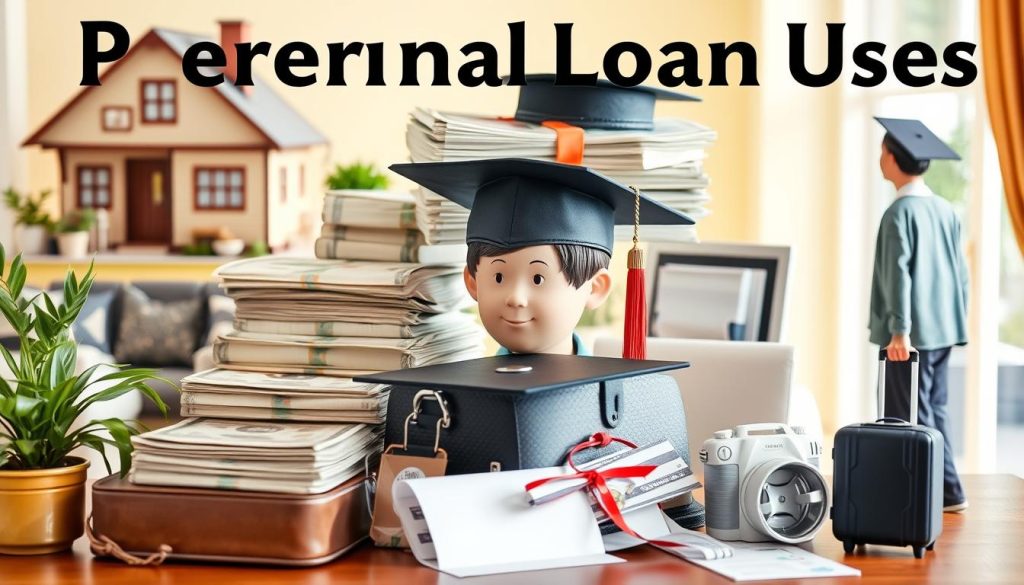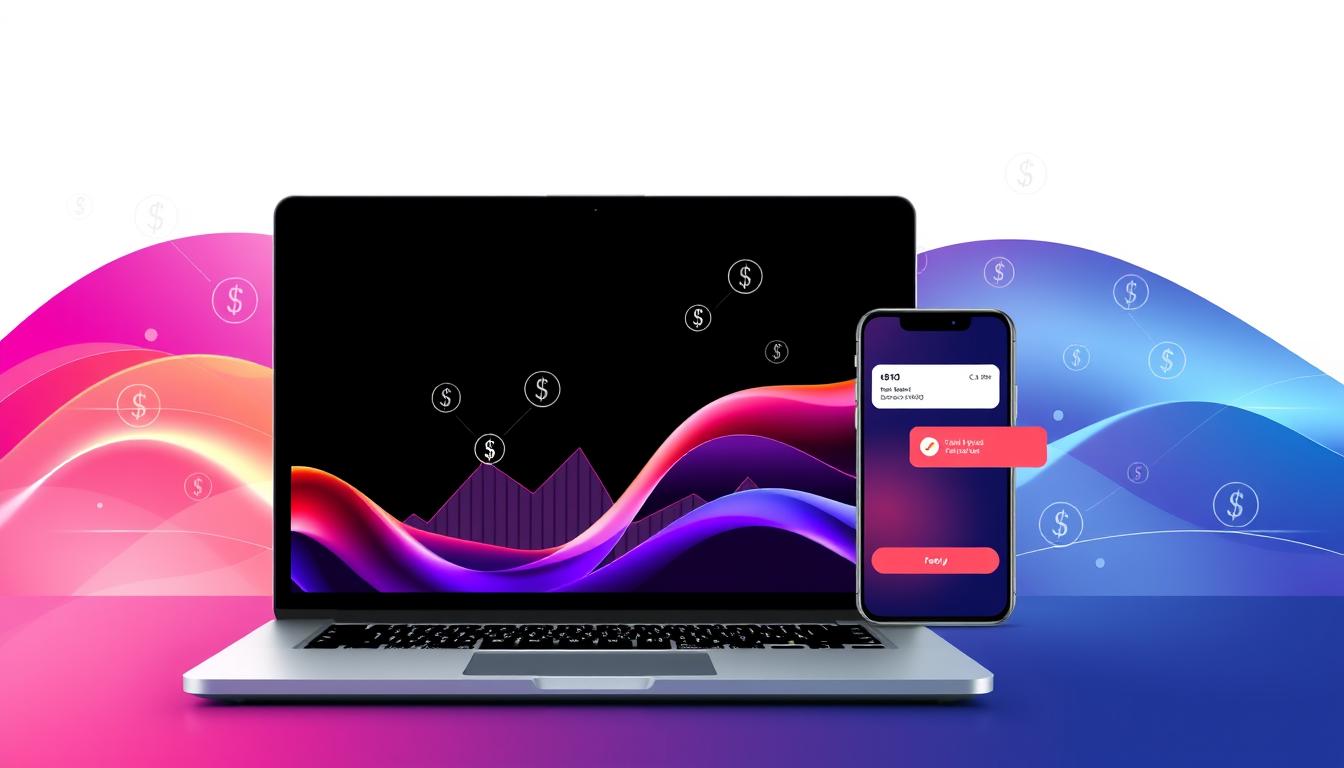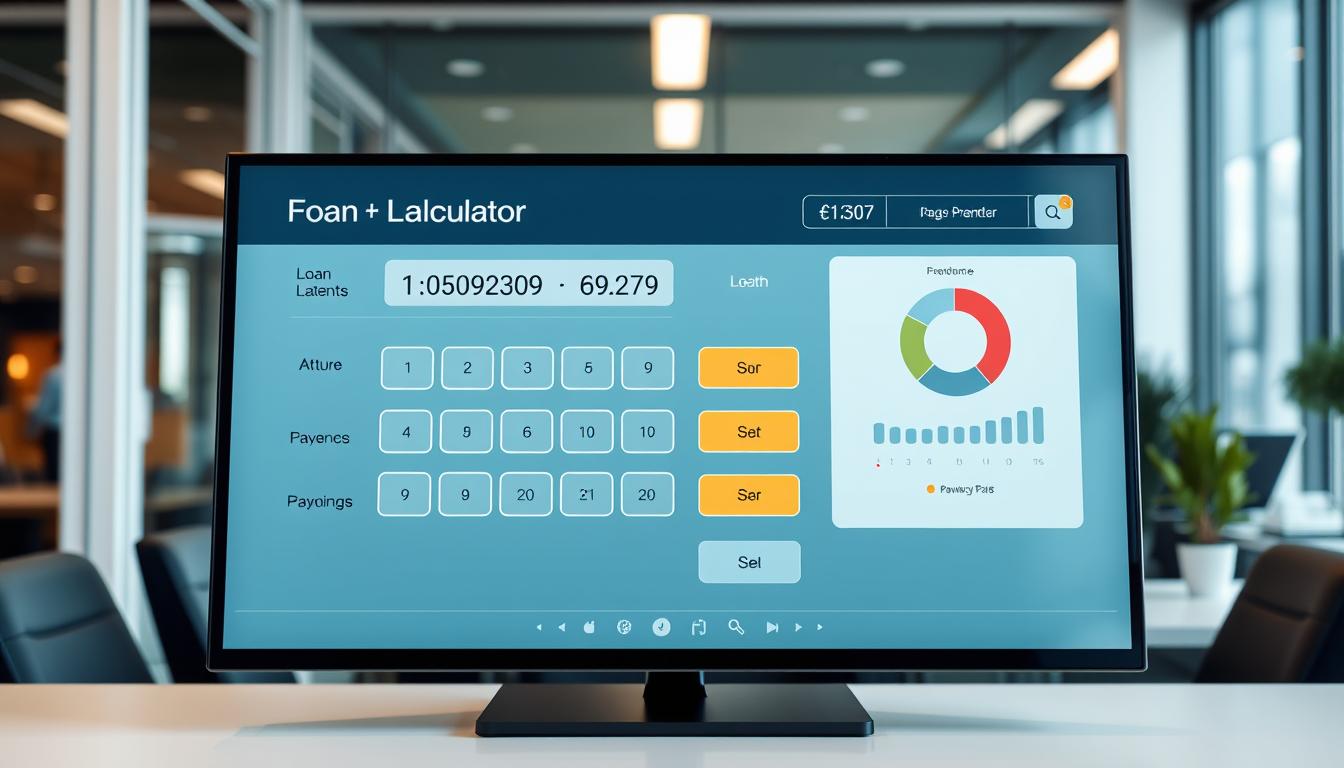In today’s fast world, unexpected costs can pop up anytime. Personal loans are a quick fix, giving you the money you need fast. Lenders like LightStream, SoFi, and Rocket Loans offer funds the same or next day. They lend from $1,000 to $100,000, with interest rates from 6.99% to 35.99%1.
These loans work for many credit scores, from 550 at Avant to 660 at LightStream and Discover1.
Need to pay off debt, cover an emergency, or fix up your home? Personal loans can help. They’re fast and flexible, making life’s money troubles easier to handle2.
Key Takeaways
- Personal loans offer fast access to cash, with some lenders providing same-day or next-day funding.
- Loan amounts range from $1,000 to $100,000, with APRs between 6.99% and 35.99%.
- Eligibility criteria vary, with minimum credit scores ranging from 550 to 660 depending on the lender.
- Personal loans can be used for a variety of purposes, including debt consolidation, home improvements, and emergency expenses.
- The application process is often streamlined, with many lenders offering online or mobile-friendly options.
What Is a Personal Loan?
A personal loan is a type of loan that gives you a sum of money upfront. You then pay it back in fixed amounts over a set time, usually 2 to 7 years3. You can use it for many things, like paying off debt, fixing up your home, or covering emergencies4.
The amount you can borrow varies a lot. It can be as low as $1,000 or as high as $100,000, depending on your credit and the lender’s rules4.
Definition of a Personal Loan
A personal loan is a loan that doesn’t need collateral, like a house or car3. The interest rate and loan terms depend on your credit score, income, and other financial details4. These loans can have fixed or variable interest rates4.
How Personal Loans Work
When you apply for a personal loan, the lender checks your credit and decides on the loan details4. You get the money all at once, and then you make fixed payments each month until it’s paid off3. Personal loans can be handy because they offer quick cash and might have lower interest rates than other options, like credit cards3.
“Personal loans can be a flexible and convenient way to access funds when you need them, whether it’s for debt consolidation, home improvements, or unexpected expenses.”
Types of Personal Loans
Borrowers have many options when it comes to personal loans. These can be secured or unsecured, and either fixed-rate or variable-rate. Knowing the differences helps you choose the right loan for your financial needs.
Secured vs. Unsecured Loans
Secured loans need collateral, like a car or home, to secure the loan5. They often have lower interest rates because of this5. Unsecured loans, however, don’t need collateral but have higher interest rates and stricter credit checks5.
Fixed-Rate vs. Variable-Rate Loans
Loans can be fixed-rate or variable-rate6. Fixed-rate loans keep the same interest rate, making payments predictable6. Variable-rate loans have rates that can change based on the market6. Fixed-rate loans are stable, but variable-rate loans might offer lower rates in some cases.
It’s crucial to research each loan’s terms, interest rates, and fees7. This way, you can choose the best loan for your financial situation. Understanding the differences helps you make a smart choice.
Benefits of Personal Loans
Personal loans come with many advantages for those needing fast cash and financial flexibility. They offer quick access to cash. Many lenders can fund you the same day or the next, helping you meet urgent needs or seize timely opportunities8.
They also let you use the money in many ways. You can pay off debts, improve your home, or cover unexpected costs. This makes personal loans great for people with different financial needs9.
Another big plus is the potentially lower interest rates compared to credit cards. Personal loan rates average 12.38%, while credit card rates are about 20.39%. This can save you hundreds or thousands of dollars over time89.
Companies like LightStream and SoFi offer even better deals. They have competitive rates and no origination fees for those who qualify. This makes personal loans even more cost-effective8.
Common Uses for Personal Loans
Personal loans are a popular choice for many needs. A 2019 Experian study found they are the fastest-growing debt type in the U.S10.. In 2019, more people took out personal loans than other types, like auto loans or mortgages10.
Debt Consolidation
Most people get personal loans to pay off other debts. The average American has about four credit cards10. Personal loans have an average interest rate of 9.34%, lower than credit cards’ 16.6%10. This makes them a good choice for combining high-interest debts into one loan.
Home Improvements
Personal loans are also used for home improvements. About 17% of consumers used them for this, according to Experian10. These loans can be from $1,000 to $100,000, with repayment times from two to seven years11. Some lenders offer longer terms for home improvement loans11.
Emergency Expenses
Personal loans can help with unexpected costs, like medical bills. Weddings can also be funded with personal loans, with the average cost over $33,00010. They can also cover education expenses, especially for online courses or new skills10. But, it’s wise to think of other funding options for vacations to avoid financial trouble10.
| Common Uses for Personal Loans | Average Loan Amount | Average Interest Rate |
|---|---|---|
| Debt Consolidation | $1,000 – $100,000 | 9.34% |
| Home Improvements | $1,000 – $100,000 | 7.99% – 35.99% |
| Emergency Expenses (Medical Bills, Weddings) | $1,000 – $100,000 | 6% – 36% |
Personal loans are versatile, helping with debt, home improvements, and emergencies11. With different amounts and rates, they can meet various financial needs and goals11.

“Personal loans offer a convenient solution for managing a variety of financial needs, from consolidating debt to funding home renovations and covering unexpected costs.”
Eligibility Criteria for Personal Loans
Lenders check several key things to decide if you can get a personal loan. They look at your credit score, how much you make, and your debt-to-income (DTI) ratio12.
Credit Score Requirements
The minimum credit score needed can change a lot between lenders. Scores usually range from 600 to 720. A higher score can lead to better loan terms12.
Those with scores over 780 might get the best rates13. But, scores under 679 could mean much higher interest for a three-year loan13.
Income Verification
Lenders have different income needs. For example, SoFi wants a yearly income of at least $45,00012. They look for steady income to show you can pay back the loan12.
Subprime lenders are more flexible. They might accept tips or Social Security as income13.
Debt-to-Income Ratio
The DTI ratio is very important too. Lenders usually want a DTI of 36% or less. But, some might go up to 50% for the best applicants12.
Homeowners should aim for a DTI of 36% or less. Renters should keep it below 21%, says the Consumer Financial Protection Bureau13. Secured loans are more common, and subprime lenders are more lenient with DTIs13.
It’s important to know that personal loan rules can change. Always compare options to find the right one for you14.
How to Apply for a Personal Loan
Getting a personal loan is easy and fast. First, find a lender that offers personal loans. Look at what Wells Fargo, Upstart, and SoFi have. They make it easy to apply online and prequalify with a soft credit check. This won’t hurt your credit score15.
After picking a lender, you’ll need to give some required documents. You’ll need to show your income, like pay stubs or tax returns. You’ll also need to prove you’re employed and have a valid ID. Some lenders might even accept other income types or job offers16.
- Get all the documents ready, like proof of income and ID.
- Fill out the online application with your financial details and how you plan to use the loan.
- Check the loan terms, like the Annual Percentage Rate (APR), loan amount, and how long you’ll pay it back. Make sure it fits your needs.
- If you get approved, accept the loan offer. Then, finish the last steps to get your money. You might get it the same day15.
By comparing lenders and knowing the application process, you can find the right personal loan. This way, you get the money you need when you need it16.
“The personal loan application process can be completed quickly, with some lenders offering same-day approval and funding.”
Understanding Interest Rates and Terms
Personal loans’ interest rates greatly affect the borrowing cost. Lenders look at your credit score, income, and debt-to-income ratio when setting rates. In 2024, the average personal loan interest rate was 25.94% in September17.
Factors Affecting Interest Rates
Your credit score is key in determining your loan’s interest rate. Those with higher scores get lower rates because they’re seen as less risky17. The loan term and borrowing costs also play a role in setting the rate17.
Loan Terms Explained
Personal loan terms usually last from 2 to 7 years17. There are different ways to calculate interest, like simple, compound, and add-on17. Unsecured loans have higher rates because they’re riskier for lenders17. Secured loans, backed by collateral, have lower rates because they’re safer for lenders17.
| Interest Calculation Method | Total Amount Paid (on a $10,000 loan at 10% APR over 5 years) |
|---|---|
| Simple Interest | $12,500 |
| Compound Interest | $13,268 |
| Add-On Interest | $13,868 |
The table shows simple interest is best for borrowers, while add-on interest is worst17. A personal loan calculator helps you see the total borrowing cost and compare options17.
When looking for a personal loan, compare offers from different lenders. This helps you find the best rates and terms for your credit profile17. Lenders must clearly state the APR, finance charges, and other important details for closed-end loans17.
Repayment Options for Personal Loans
Personal loans usually come with fixed monthly payments. Many lenders offer discounts for autopay, cutting the APR by 0.25% to 0.50%18. This can save a lot over the loan’s life. Some, like OneMain Financial, let you pick your payment due date, giving you more flexibility19.
Most lenders don’t charge for early payoff, but always check the fine print19. Late fees can be steep, from $15 to $39, or a percentage of the missed payment19. So, paying on time is key to avoid extra costs.
Benefits of Flexible Repayment Options
Customizing your payments can greatly reduce your loan’s cost19. Paying a bit more each month can cut down interest. Making bi-weekly payments adds an extra payment each year, saving even more18. A big payment can also lower your interest over time18.
Debt consolidation through a personal loan can simplify payments and improve your credit score by clearing revolving debt19. Refinancing can also save on interest. Negotiating with your lender for better terms can further help manage your loan18.
| Repayment Option | Key Benefit |
|---|---|
| Autopay Discounts | Reduce APR by 0.25-0.50% |
| Flexible Payment Due Dates | Choose preferred payment date |
| No Prepayment Penalties | Pay off loan early without fees |
| Larger Monthly Payments | Reduce total interest paid |
| Bi-Weekly Payments | Add extra payment each year |
| Lump Sum Payments | Lower overall interest paid |
Knowing your repayment options can save you thousands in interest18. Smart borrowing and managing your loan can bring big financial gains19.
“Flexible repayment options can make a substantial difference in the overall cost of a personal loan. Exploring these options can lead to significant savings for borrowers.”
Potential Risks of Personal Loans
Personal loans can be helpful, but they also have risks. One big worry is building up too much debt. The interest rates on personal loans can be high, making it hard to pay back if not managed well20.
Another risk is how personal loans can affect your credit score. Getting a loan might lower your score at first, but paying on time can help it go up21. But, if you can’t pay back the loan, it can really hurt your credit and lead to collections20.
Debt Accumulation
Getting a personal loan can add to your financial stress if not handled right. Loans usually range from $1,000 to $100,000, which might seem appealing for quick money20. But, too much debt can make it hard to keep up with payments, especially if the interest is high.
Impact on Credit Score
Personal loans can affect your credit score a lot. They make up 30% of your FICO score, and how you pay them back is another 35%20. Getting a loan might lower your score at first, but paying on time can help it go up21. But, not paying back a loan can really hurt your credit and lead to collections20.
To avoid these risks, it’s crucial to think about your finances carefully. Look for the best rates and terms, and make a solid plan to pay back the loan. By understanding the risks and managing your loan wisely, you can enjoy its benefits without the downsides.
“Responsible borrowing is key when it comes to personal loans. Understanding the potential risks and developing a solid repayment plan can help ensure a positive financial outcome.”
Tips for Finding the Best Personal Loan
When looking for the best personal loan, it’s important to compare offers from different places. This means checking out banks, credit unions, and online lenders to find the best deal22. Using prequalification tools can also help you guess interest rates without hurting your credit score22.
Don’t just look at APRs. Make sure to read about any extra fees, like origination fees, prepayment penalties, and late fees22. Knowing the loan terms and any possible charges can prevent unexpected costs later22.
Look for lenders that offer extra perks, like SoFi’s job protection or LightStream’s Rate Beat program22. Also, check the lender’s customer service and reviews to ensure a smooth experience22.
Compare Multiple Lenders
- Use loan comparison websites to check offers from credit unions, online lenders, and bank loans23.
- Use prequalification tools to guess interest rates without affecting your credit score22.
- Compare APRs, fees, and loan terms from different lenders22.
Read the Fine Print
- Read carefully about any origination fees, prepayment penalties, and late fees22.
- Know the loan repayment schedule and any possible charges to avoid surprises22.
- Look for lenders with extra benefits, like job protection or rate-matching programs22.
By doing your research and comparing lenders, you can find the best personal loan for your needs22. Taking the time to understand the terms and conditions helps you make a smart choice. This ensures a positive borrowing experience22.
“Comparing offers from multiple lenders is key to securing the best personal loan. Read the fine print and look for added benefits to find the right fit for your financial situation.”

Conclusion
Personal loans can be very helpful when used right. They offer quick money for many needs, like paying off debt or fixing up your home24. But, it’s important to think about how they’ll affect your money in the long run.
Making Informed Decisions
When looking for a personal loan, compare what different lenders offer. Make sure you understand the terms and choose a loan that fits your budget25. Look at the interest rate, fees, and APR to get a good deal26. This way, you can use the loan to your advantage without running into trouble.
The Importance of Responsible Borrowing
Being smart about borrowing is crucial for your financial health24. Pay on time, keep an eye on your loan balance, and talk to your lender if you have problems25. Good borrowing habits can help your credit score improve, leading to better rates later on24. Remember, personal loans should be part of a bigger plan, not a way to spend too much or get into more debt.
FAQ
What is a personal loan?
What are the different types of personal loans?
What are the benefits of getting a personal loan?
What are common uses for personal loans?
What are the eligibility criteria for personal loans?
How do I apply for a personal loan?
How are personal loan interest rates and terms determined?
How are personal loans repaid?
What are the potential risks of getting a personal loan?
How can I find the best personal loan for my needs?
Source Links
- Quick Loans: Best Lenders for Fast Cash in 2024 – NerdWallet
- Best Fast Personal Loans For Quick Cash Of 2024
- Personal Loan: Definition, Types, and How to Get One
- What Is A Personal Loan? What To Know Before You Apply | Bankrate
- 8 Types Of Personal Loans — Plus 5 Types To Avoid | Bankrate
- 6 Types of Personal Loans and When They’re Best – NerdWallet
- What Is a Personal Loan and How Does It Work?
- Pros And Cons Of Personal Loans: Should You Get One? | Bankrate
- Should I Get A Personal Loan? 9 Top Reasons | Bankrate
- 8 reasons why people take out personal loans, and what to consider if you do
- Top 5 Reasons to Get a Personal Loan – NerdWallet
- 5 Personal Loan Requirements To Know Before Applying
- What Are the Requirements for a Personal Loan?
- What Are Personal Loan Eligibility Requirements?
- Personal loans: See options and apply online
- How To Get A Personal Loan: 9 Steps & Expert Tips | Bankrate
- How Personal Loan Interest Rates Work
- The Best Way To Pay Off A Personal Loan: Top Tips | Bankrate
- Managing Personal Loans With Monthly Payments
- Pros And Cons Of Personal Loans
- Unsecured Personal Loans: 8 Sneaky Traps
- How To Choose The Right Personal Loan In November 2024
- Best Personal Loans Of November 2024: Compare Top Lenders
- Understanding the Pros and Cons of Personal Loans | Driva
- The Ultimate Guide to Understanding Personal Loans | TDECU
- Everything You Need to Know About Personal Loans: A Comprehensive Guide – LendingUSA



